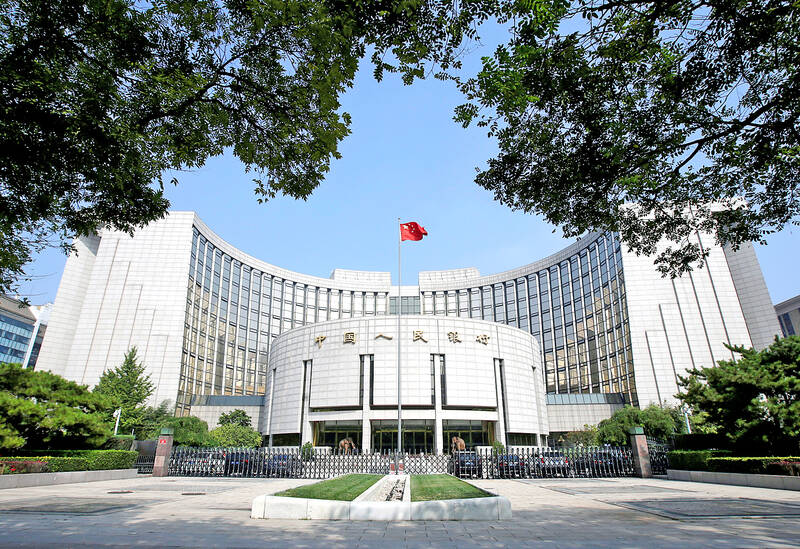China’s central bank lowered the interest rate charged on its one-year policy loans by the most on record, kicking off a sweeping program to revive confidence in the world’s second-largest economy.
The People’s Bank of China (PBOC) cut the rate of the medium-term lending facility (MLF) to 2 percent from 2.3 percent, according to a statement yesterday. The 30-basis-point cut was the biggest since the bank began using the monetary tool to guide market interest rates in 2016.
The expected move followed PBOC Governor Pan Gongsheng’s (潘功勝) announcement the previous day of a broad stimulus package that amounted to an adrenaline shot for an economy on the cusp of a deflationary spiral.

Photo: Reuters
“The cut is part of the package,” said Bruce Pang (龐溟), chief economist for Greater China at Jones Lang LaSalle Inc.
“The market is keeping a close eye on the strength, frequency and synergy of measures to follow as China strives to achieve this year’s around 5 percent growth goal,” Pang said.
The cut to the MLF rate is a prelude to more significant measures, such as a promised reduction in the rate on seven-day reverse repurchase notes, which the PBOC increasingly favors as the main policy lever.
The rate on those instruments would be lowered by 20 basis points to 1.5 percent “soon,” Pan said on Tuesday.
“Looking ahead, we see room for the PBOC to do more on the rates front than Pan has signaled so far. There’s a chance the central bank could trim the seven-day reverse repo rate by a further 10 [basis points] on top of the move Pan flagged on Tuesday,” Bloomberg economist David Qu (曲天石) said.
Reflecting the new framework, the monetary authority withdrew a net 291 billion yuan (US$41.4 billion) via the MLF, the biggest drainage since December 2021.
The outstanding MLF loans are widely expected to be gradually replaced by other tools, including cash injections through reserve requirement ratio (RRR) cuts, as the PBOC seeks to influence market borrowing costs more effectively.
“The MLF may be downgraded to become a tool to adjust the marginal borrowing costs of banks,” said Xing Zhaopeng (邢兆鵬), senior strategist at Australia & New Zealand Banking Group. “The MLF rate in the future could change following movements in market rates.”
The central bank chief revealed a plan to unleash 1 trillion yuan in long-term liquidity with a 50 basis-point reduction of the RRR, which determines the amount of cash lenders must keep in reserve. Along with other new funding tools, the measures more than compensated for the effect of the net withdrawal on market liquidity.
“Looking ahead, there is room for further replacement of MLF liquidity with RRR cut-induced liquidity given heavy MLF maturity in the coming months,” said Frances Cheung, (張淑嫻) a strategist at Oversea-Chinese Banking Corp.
The rate cut on the one-year lending yesterday “renders the facility more aligned with the funding costs” in the interbank market, she added.

Quanta Computer Inc (廣達) chairman Barry Lam (林百里) is expected to share his views about the artificial intelligence (AI) industry’s prospects during his speech at the company’s 37th anniversary ceremony, as AI servers have become a new growth engine for the equipment manufacturing service provider. Lam’s speech is much anticipated, as Quanta has risen as one of the world’s major AI server suppliers. The company reported a 30 percent year-on-year growth in consolidated revenue to NT$1.41 trillion (US$43.35 billion) last year, thanks to fast-growing demand for servers, especially those with AI capabilities. The company told investors in November last year that

Intel Corp has named Tasha Chuang (莊蓓瑜) to lead Intel Taiwan in a bid to reinforce relations between the company and its Taiwanese partners. The appointment of Chuang as general manager for Intel Taiwan takes effect on Thursday, the firm said in a statement yesterday. Chuang is to lead her team in Taiwan to pursue product development and sales growth in an effort to reinforce the company’s ties with its partners and clients, Intel said. Chuang was previously in charge of managing Intel’s ties with leading Taiwanese PC brand Asustek Computer Inc (華碩), which included helping Asustek strengthen its global businesses, the company

Taiwanese suppliers to Taiwan Semiconductor Manufacturing Co. (TSMC, 台積電) are expected to follow the contract chipmaker’s step to invest in the US, but their relocation may be seven to eight years away, Minister of Economic Affairs J.W. Kuo (郭智輝) said yesterday. When asked by opposition Chinese Nationalist Party (KMT) Legislator Niu Hsu-ting (牛煦庭) in the legislature about growing concerns that TSMC’s huge investments in the US will prompt its suppliers to follow suit, Kuo said based on the chipmaker’s current limited production volume, it is unlikely to lead its supply chain to go there for now. “Unless TSMC completes its planned six

Power supply and electronic components maker Delta Electronics Inc (台達電) yesterday said it plans to ship its new 1 megawatt charging systems for electric trucks and buses in the first half of next year at the earliest. The new charging piles, which deliver up to 1 megawatt of charging power, are designed for heavy-duty electric vehicles, and support a maximum current of 1,500 amperes and output of 1,250 volts, Delta said in a news release. “If everything goes smoothly, we could begin shipping those new charging systems as early as in the first half of next year,” a company official said. The new